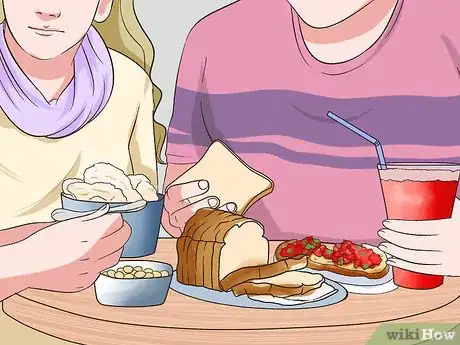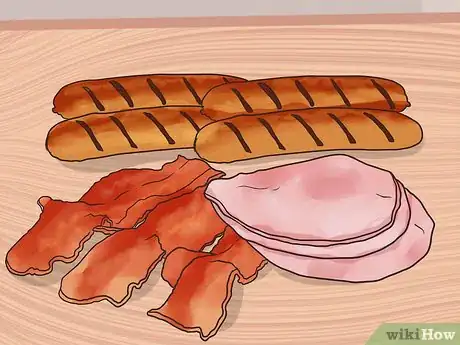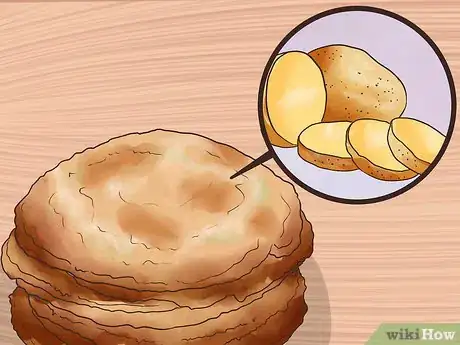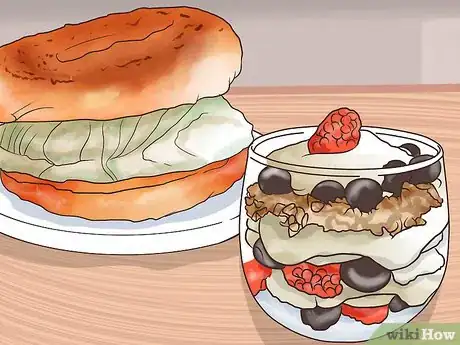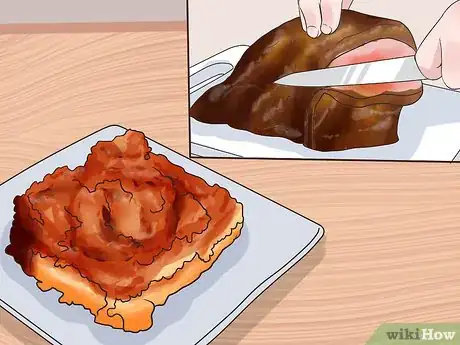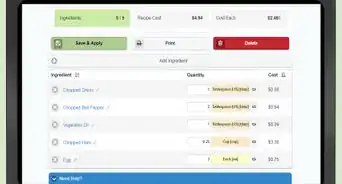This article was co-authored by Sasha Reyes. Chef Sasha Reyes is the Executive Chef and Owner of Artisan Personal Chefs. With over 20 years of food industry experience, she specializes in private dinner parties, custom sports nutrition plans for professional athletes, and cooking lessons. Chef Reyes graduated from Arizona Culinary Institute in 2011 with a degree in Culinary Arts, Baking, and Restaurant Management.
There are 14 references cited in this article, which can be found at the bottom of the page.
This article has been viewed 108,594 times.
Brunch is a meal that combines food items from both breakfast and lunch, hence the term brunch. It is usually served in the late morning or early afternoon times, and is associated with Sunday when people tend to rise later than usual.[1] Not only can the time of brunch differ, but so can the menu choices. With so many food and drink options, planning a brunch menu may seem to be a difficult task, but with proper planning you can put together a fabulous event.
Steps
Doing the Background Work
-
1Determine your guest count. It’s important to know how many people will be dining because it can affect the type of brunch service you choose. Sit-down brunches are great for small parties, while buffet-style brunches are preferable for large parties.[2] There are no set rules regarding the number of guests required for each type of service; it depends on both the type of food being served as well as the amenities for service. Once your guest list is set, you can decide your service style which will set the tone for the food being served.
- For example, fresh pancakes may be feasible for 6 guests but for 20 it can prove to be difficult.
- Sit-down services typically have a set menu from which guests can choose from various offerings.
- Buffet-style brunch tends to offer wider a selection of options including omelet or pancake stations.[3]
-
2Find out special food preferences. Determine if you have guests who require unique menu items. For example, ask your guests if they are vegetarian, vegan, or have food allergies. This will allow you to have a few items available for those who don’t eat traditional brunch menu items such as meat products, eggs, or items cooked with allergy causing ingredients such as peanuts.Advertisement
-
3Determine if you will have a theme. Brunches don’t usually require a theme, but if you are planning a themed brunch it can affect your choice of menu items. For example, if you’re hosting a tea themed brunch you’re more likely to serve tea instead of mimosas. On the other hand, if your theme is a vintage-style brunch you’ll be more likely to serve traditional dishes like eggs benedict or bagels and lox.
- Examples of themed brunches include vintage-style, tea party, garden party, formal affair, or springtime soiree.[4]
-
4Choose catering or cooking. Catering a brunch tends to limit your menu options while choosing to cook your own food allows you absolute freedom. The choice to cater or cook depends on your cooking ability, the number of guests, your budget, and your available time.
- Catering costs vary greatly. Some companies offer fixed pricing where the menu item has a set price, tiered pricing where prices are lowered for bulk orders, or custom pricing which is based on each event.[5]
- If you are planning to cook food items yourself, you can always start the night before. Set out napkins and utensils, make the mix for drinks, and cook items that will hold well over night such as French toast.[6]
-
5Include foods from various groups. Brunch is an opportunity to create a spread of meal options for guests to pick and choose from as they please. A brunch menu should provide a well-balanced array of foods from all of the 5 food groups: dairy, fruit, grain, meats and poultry, and vegetables and beans.[7]
Choosing Breakfast Items
-
1Consider what meats to serve. Bacon, sausage and ham are traditional meat choices for breakfast. When serving bacon, choose to cook it in the oven instead of the stovetop. Not only can you cook larger portions, but you can turn off the oven and keep the bacon warm during brunch.[8]
-
2Choose how to prepare your eggs. Because eggs are usually the central focus of breakfast and brunch, choose to offer more than one type of egg dish. Quiches and frittatas can be prepared the night before and mixed with various veggies, or egg scrambles can be prepared quickly and mixed with items such as meat and potatoes.
- Omelette bars are often staples of brunches because your guests can customize their egg dish. They are typical of buffet style services but require time and patience.[9]
- Eggs benedict is also a traditional brunch choice. It includes an English muffin topped with Canadian bacon, a poached egg, and topped with hollandaise sauce.[10]
-
3Include vegetables on your menu. Potatoes are common brunch additions, as they can be made into hash browns or potato pancakes. Hash browns and roasted potatoes are not only easy to cook, but they can also be spruced up by adding extras such as spinach, onions and peppers, or cheese. They may also be added to omelets, quiches and breakfast casseroles.[11]
-
4Add bread products to your spread. Grain products are extremely versatile and help to keep guests full. In addition, they can be both savory and sweet. Try bagels with smear, a baguette with jam or butter, scones, muffins, pancakes, or French toast.
- French toast and scones can be prepared and frozen two weeks ahead of time. Simply place them in the oven the morning of the event.[12]
- Bagels are versatile because they can be served as lox with cream cheese and cured salmon. Lox are a staple at traditional New York style brunches.
-
5Choose dairy products to include. While dairy products don’t constitute a major portion of a brunch menu, it’s still important to include dairy products to balance out a menu. Acceptable dairy products for brunch include cream cheese for bagels and yogurt parfait. Additionally, cheese can be mixed into casseroles and eggs for extra flavor.
-
6Include drinks on the menu. Coffee, tea, milk, and juice are staples of brunch.[13] Be sure to supply options for sprucing up drinks such as sugar, cream, and flavorings. If you have a coffee maker, you can quickly whip up a pot of an inexpensive roast. Otherwise, you can purchase a jug from a breakfast shop.[14]
Choosing Lunch Items
-
1Offer carved meats. Because brunch straddles breakfast and lunch, you have the option to serve less traditional protein choices. Try including heavier meat options like steak or prime rib.[15]
- If you have a buffet-style service, include a carving station. Allow the meat to rest on a cutting board, carve a few slices ahead of time, and make the carving knife readily available if needed. For sit-down services, you can carve the meat ahead of time.[16]
- You can also get away with serving seafood by including items such as cured salmon for lox and crab dip for crostini’s.
-
2Include seasonal veggies. Seasonal vegetables are fresh vegetables that are only available during certain seasons. Each year’s offering is different, and individual varieties of vegetables have different harvest times.[17] You can check your local farmer’s market for availability.
- A great cooking method for most vegetables is to roast them and serve them as a side dish. Additionally, they can be added to eggs and sandwiches.
- Veggies are extremely versatile and work well as a refreshing cold dish or served raw. Try veggies served with cheese (tomatoes and mozzarella) or veggie “slaws” such as broccoli slaw.[18]
- Store-brought platters are a quick and easy way to add veggies to the menu.
-
3Serve bread products. A baguette or a loaf of bread is a quick and cheap way to bulk up your meal. Not only does it keep your guests entertained while you’re cooking, but it can also be used to make savory sandwiches or slathered in jam for a sweet alternative.
- Toast the entire loaf for 10-15 minutes before serving.
- Rub a bit of water over the crust with your hands if the bread gets too rubbery or soft.[19]
-
4Complement breakfast items. Because brunch straddles the line between breakfast and lunch, try pairing classics from both. For example, try pairing a sweet coffee cake with a savory dish like carved meat. This will not only offer your guests variety but will also keep them full for hours.
- The appeal of brunch is that it is a hodge-podge collection of food items. Feel free to pick and choose savory and sweet menu items even if you feel they don’t pair well together. Your guests might enjoy the variety.
-
5Serve finger foods. Finger foods are small bites of food that are flavorful, easy to fix, and easy to eat with your hands. Try egg mixtures baked into muffin bites, ham and cheese wraps, or sandwiches made on bruschetta or crostini.[20]
- Not only are finger foods usually inexpensive, but they can also be prepared ahead of time and frozen.
- Simple sandwiches are a great finger food. Choose your favorite meats, cheeses, and breads and slice into smaller portions to feed more guests.
-
6Choose your drinks. Aside from coffee and orange juice, pitcher drinks and punch bowls are great ideas to add an additional level of flavor. There are also many brunch menus that include alcoholic beverages such as mimosas or bloody marys.
- Choose beverage options based on your guest list. For example, if many children will be present, milk and juice are maybe more appropriate than mimosas.
- You can provide mixers and allow guests to bring their own bottle of liquor (BYOB) such as Vodka or champagne.[21]
- Stay away from drinks that have to be repeatedly mixed or alcoholic drinks that are too strong.[22]
Community Q&A
-
QuestionHow do you make a mimosa?
 Community AnswerUse dry champage instead of a sweet champagne like spumante. The type of orange juice is a matter of personal preference and can be fresh squeezed, store bought, or with or without pulp. Add equal parts champagne and orange juice, making sure to pour the champagne first. Do not stir, as this will cause the champagne to become flat. Do not serve over ice.
Community AnswerUse dry champage instead of a sweet champagne like spumante. The type of orange juice is a matter of personal preference and can be fresh squeezed, store bought, or with or without pulp. Add equal parts champagne and orange juice, making sure to pour the champagne first. Do not stir, as this will cause the champagne to become flat. Do not serve over ice. -
QuestionWhat is the cost to do a simple brunch for 100 people?
 Community AnswerI think it would cost around 1500 dollars or more depending on the amount and the quality of the dishes you want.
Community AnswerI think it would cost around 1500 dollars or more depending on the amount and the quality of the dishes you want. -
QuestionWhat drinks should be served?
 Community AnswerLight drinks should be served such as mint margarita, lemonade and all types of smoothies.
Community AnswerLight drinks should be served such as mint margarita, lemonade and all types of smoothies.
Warnings
- Avoid cooking more than one item on the stovetop.⧼thumbs_response⧽
- Avoid trying to prepare all items on the morning of the event. Instead, choose only one or two items that require your attention on the day of the brunch.⧼thumbs_response⧽
Expert Interview
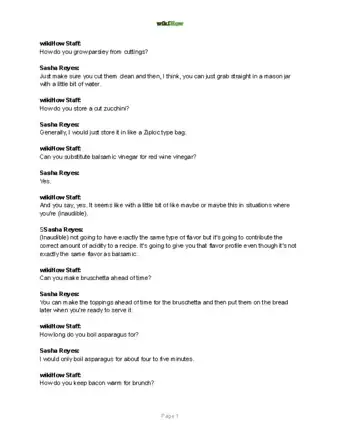
Thanks for reading our article! If you'd like to learn more about cooking tips, check out our in-depth interview with Sasha Reyes.
References
- ↑ https://www.quora.com/What-is-the-exact-difference-between-breakfast-lunch-brunch-dinner-and-meal
- ↑ https://enlightenme.com/what-are-brunch-foods/
- ↑ https://enlightenme.com/what-are-brunch-foods/
- ↑ https://enlightenme.com/what-are-brunch-foods/
- ↑ http://www.foodservicewarehouse.com/blog/price-catering-menu/
- ↑ http://www.thekitchn.com/hosting-brunch-without-the-stress-196982
- ↑ https://www.healthychildren.org/English/healthy-living/nutrition/Pages/The-5-Food-Groups-Sample-Choices.aspx
- ↑ http://www.thekitchn.com/hosting-brunch-without-the-stress-196982
- ↑ https://enlightenme.com/what-are-brunch-foods/
- ↑ https://enlightenme.com/what-are-brunch-foods/
- ↑ https://www.yahoo.com/style/how-to-create-a-simple-brunch-menu-129288749616.html
- ↑ http://www.thekitchn.com/hosting-brunch-without-the-stress-196982
- ↑ https://enlightenme.com/what-are-brunch-foods/
- ↑ http://www.biggirlssmallkitchen.com/2011/01/how-to-have-people-over-for-brunch.html
- ↑ https://enlightenme.com/what-are-brunch-foods/
- ↑ http://www.australian-lamb.com/Lamb/Cooking_with_Lamb/Carving_and_Serving/
- ↑ http://www.cuesa.org/eat-seasonally/charts/vegetables
- ↑ http://www.chowhound.com/post/vegetable-dish-brunch-999937
- ↑ http://www.biggirlssmallkitchen.com/2011/01/how-to-have-people-over-for-brunch.html
- ↑ http://www.brit.co/breakfast-brunch-finger-foods/
- ↑ http://www.biggirlssmallkitchen.com/2011/01/how-to-have-people-over-for-brunch.html
- ↑ https://www.yahoo.com/style/how-to-create-a-simple-brunch-menu-129288749616.html
About This Article
To create a brunch menu, start by determining how many guests you'll have since this will impact what you're able to offer. For example, if you serve bacon to a large group, make it in the oven to cook bigger portions and keep it warm. For eggs, quiches and frittatas can be prepared the night before, while an omelette bar is a fun addition for a small or catered event. No matter the size of the event, bagels and cream cheese, baguettes with jam or butter, scones, muffins, pancakes, and french toast are all great brunch staples. To learn how to include lunch items on your brunch menu, keep reading!




